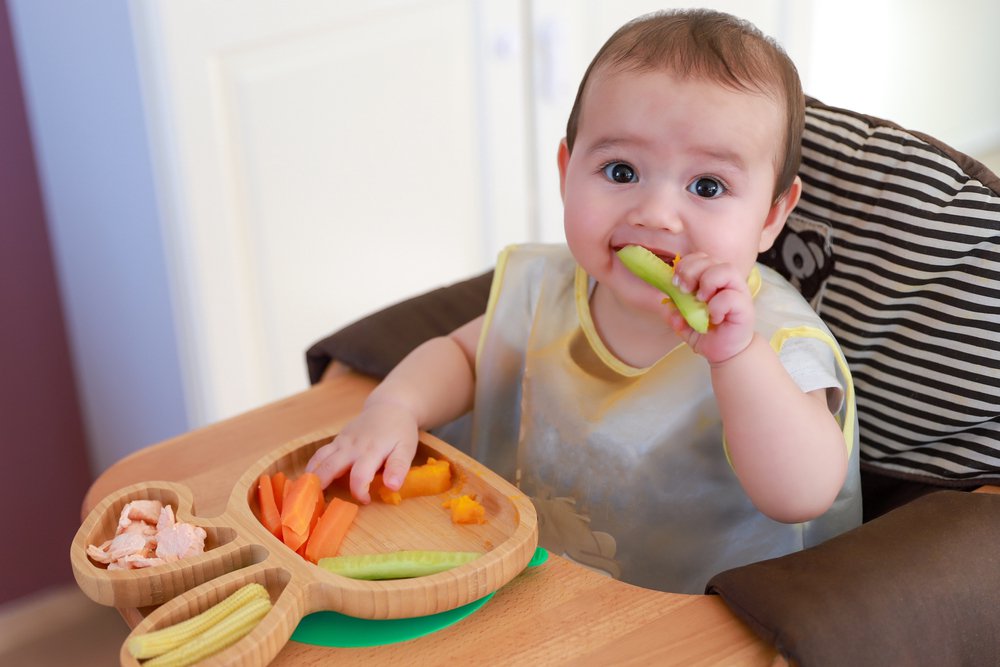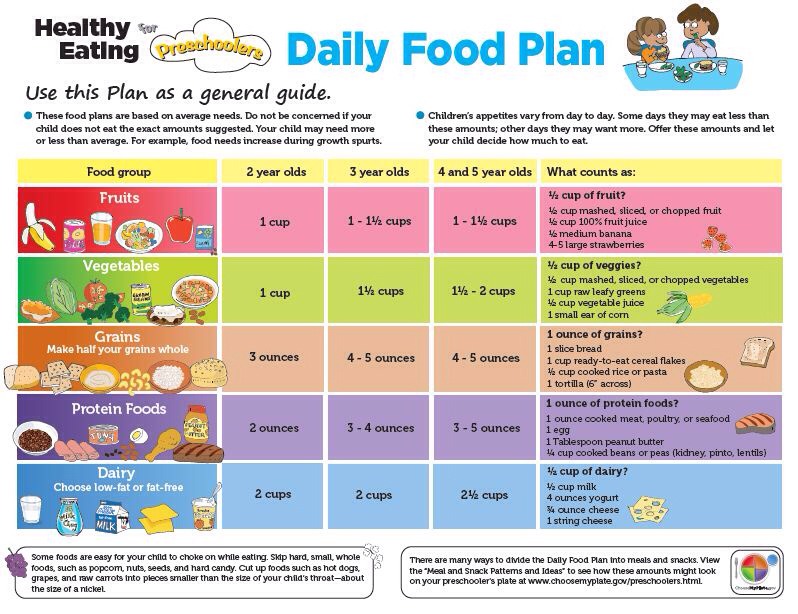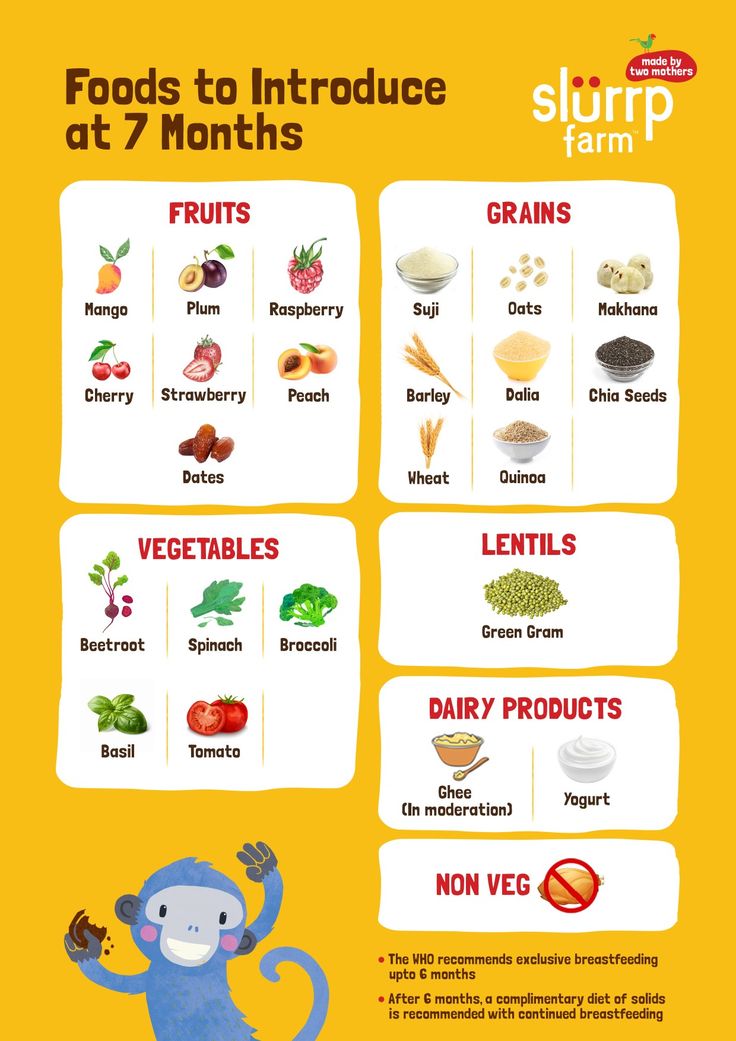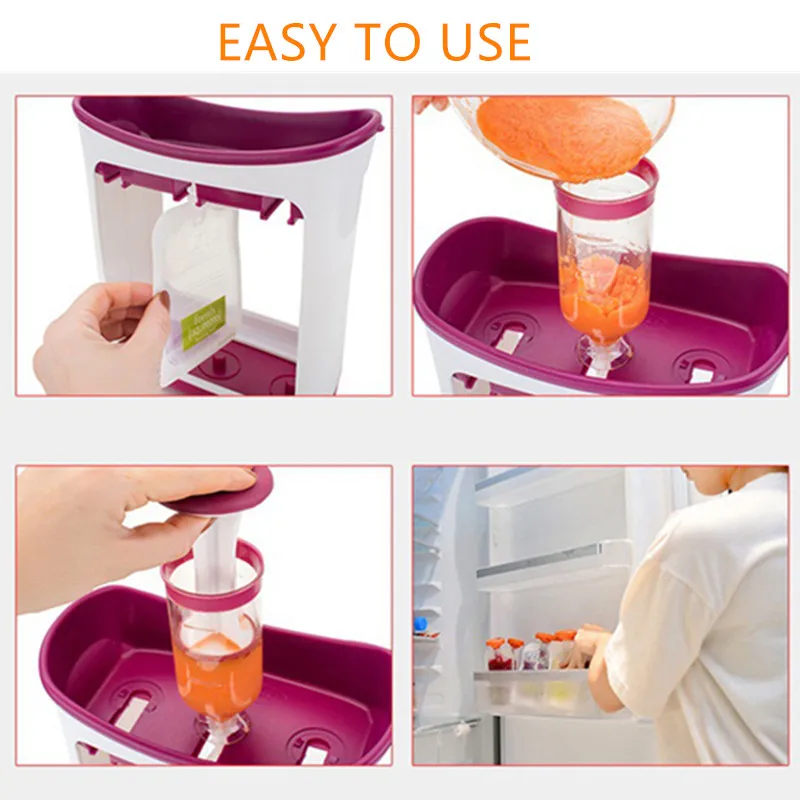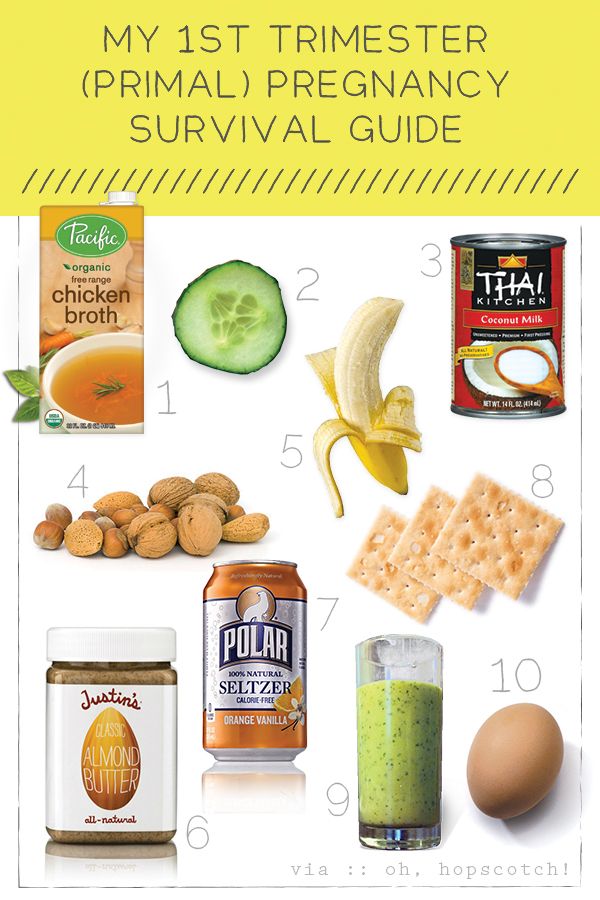Baby feed himself
7 Tips for Teaching Your Baby to Self-Feed
Now that your baby has been introduced to solids and is experiencing different foods and flavors, you may be ready to help your little one begin to self-feed. But when is the right time to encourage this new skill? What are the signs of readiness that we should look for? And what are the best foods to begin with when teaching baby to self-feed? We are answering all of your questions and sharing our tips on making this milestone easier for you and your child.
When will my baby be able to self-feed?
Usually, by about nine to 12 months of age, you may notice your baby showing an interest in self-feeding. They have become more experienced with eating solids at this age and are feeling the different textures of foods between their fingers. Hopefully, they are also making attempts at bringing some of that food to their mouth to lick and taste. This usually looks like them grasping for their food with their whole hand in a raking-like motion and then trying to shove what they have in their hand all into their mouth. You may even notice your baby trying to grab the food with their thumb and forefinger, which is an important fine motor skill called the pincer grasp. These are all good signs and are great indications that your baby is ready to begin self-feeding.
What are the signs that my baby is ready to self-feed?
There are a few readiness signs to look for that will indicate it’s the right time to begin teaching your baby to self-feed:
- Grabbing the spoon while you are holding it during mealtime.
- Reaching for their food on their plate, bowl, or tray.
- Reaching for your food or plate.
- Practicing the pincer grasp — bringing food and other items to their mouth during mealtime or playtime.
- Pushing your hand away when you try to feed them.
It’s important to pay attention to these readiness signs and not just rely on your child’s age. If a baby is 9 or 10 months old but does not show these readiness signs, parents should wait until they do. But once your baby does show these self-feeding readiness signs, it’s important to provide many opportunities for them to practice this skill. Allow them to try and try again. That’s how they will learn and master this skill!
But once your baby does show these self-feeding readiness signs, it’s important to provide many opportunities for them to practice this skill. Allow them to try and try again. That’s how they will learn and master this skill!
What are the best foods to start with self-feeding?
The best foods to give your baby to practice self-feeding are easy for them to grab, hold, pick up, and bring to their mouth. Here are some recommendations to try:
- Stonyfield YoBaby Pouches
- Soft cooked carrots, sweet potatoes, butternut squash, or peas
- Small pieces of soft, ripe bananas, avocados, kiwi, or peaches
- Soft-cooked apples or pears
- Soft-cooked whole grain pasta
- Diced pieces of cooked chicken, turkey, or fish
- Cubes or strings of cheese
YoBaby® yogurt pouches are a great option for multiple reasons. First, they are easy for your little one to pick up and bring to their mouth. Second, they nourish little tummies with real fruit, live and active cultures, vitamin D, calcium, protein, and prebiotics! Third, the consistency is creamy and delicious — easy for baby to eat and swallow. And four, it combines whole milk yogurt and oats for a quick meal for baby!
And four, it combines whole milk yogurt and oats for a quick meal for baby!
All foods should be soft, easy to mash, and big enough for your baby to pick up but small enough to prevent them from choking.
What are the foods to avoid when my baby is beginning to self-feed?
Foods that should be avoided when beginning to teach your baby to self-feed are foods that pose a potential risk of choking.
- Nuts
- Popcorn
- Raw carrots
- Whole grapes
- Raisins
- Hot dogs
- Portions of food that are too large
Your baby doesn’t have all of his teeth, so all foods should be soft. Once your baby’s 2-year molars come in, your child will be able to chew harder food properly. If you want to test to see which foods are safe and soft enough for your baby to eat, take a piece of their food and try to mash it between your fingers. If you cannot easily mash it, it’s probably too hard for your baby to chew.
How do I teach my baby to self-feed?
Now that you know your baby is ready to start self-feeding and you know which foods are best to start with, how do you begin? Here are some helpful tips.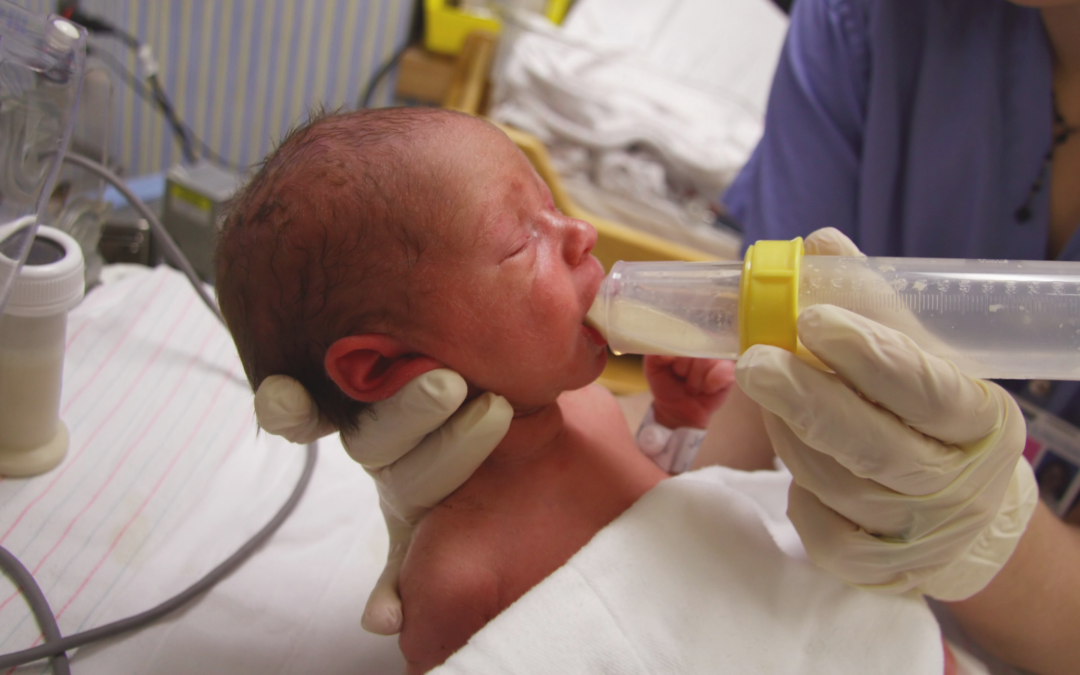
The more opportunities you give them to practice, the quicker they will learn and master self-feeding. Give them opportunities to try self-feeding with their hands and with utensils.
2. Begin with encouraging hand feeding.Before introducing feeding utensils to your baby, encourage her first to use her hands to move the food toward her mouth. A good way to start is to place a yogurt pouch or a few pieces of food on your baby’s highchair tray. Encourage her to reach for it, feel it, and play with it with her pincer grasp. It may look as if she isn’t doing much and not eating, but that’s actually how she starts to learn.
3. Also, introduce and encourage baby to use utensils.It’s never too early to introduce utensils to your baby! It’s good for them to get used to utensils during mealtime. In the beginning, I recommend having two spoons–one for you to help feed baby a few bites and one for them to hold and practice using. He may even try to imitate your motions by dipping his spoon into the food and maybe attempting to bring it to his mouth.
He may even try to imitate your motions by dipping his spoon into the food and maybe attempting to bring it to his mouth.
Another thing you can try is pre-loading his spoon with food and handing it to him. This can help him practice balancing the food on the spoon as he brings it to his mouth. With this, I recommend using thicker foods like yogurt and oatmeal. They are good practice foods since they stick more easily to the spoon. Overall, be sure to allow plenty of practice opportunities with both utensils.
4. Stay close to your baby during meals.As your baby practices self-feeding, it’s important that you stay close and monitor her. We don’t want any food getting stuck in her nose or anywhere else, and you want to ensure that she is tolerating all of the new textures and flavors. By staying close, you will also monitor how much or little she is putting in her mouth and eating. These are all reasons why remaining by her side is necessary. She’s learning something new, and she needs your help and guidance!
5. Be prepared and expect a big mess.
Be prepared and expect a big mess.When babies are allowed to touch and explore new foods and feeding themselves, things get messy. And that’s okay! Don’t stress about it, and expect the mess. Have your baby wear a baby apron, put a towel on the floor if you’re worried about food falling, or undress your baby down to her diaper! Also, have baby wipes and power towels close by. You may even have to give your baby a bath after mealtime. Again, this is normal. A messy meal is still a success because that means your baby was trying to self-feed. Soon enough, she’ll get better at handling the different foods and make less of a mess. This is all a part of the process.
6. Eat together as a family.One of the best ways to teach your baby to self-feed is to have them watch the family eat. Babies are learning new things all the time, and they learn from modeled behaviors. By watching how their parents and siblings use their utensils and eat their food, babies want to mimic the same behaviors. They gain confidence watching you and believe that they can do it too! If you are feeding your baby at a different time than the rest of the family, they are missing out trying to mimic your movements with utensils and foods and observing other appropriate mealtime behaviors.
They gain confidence watching you and believe that they can do it too! If you are feeding your baby at a different time than the rest of the family, they are missing out trying to mimic your movements with utensils and foods and observing other appropriate mealtime behaviors.
It takes time to learn how to self-feed, so be patient with your little one. Don’t try to rush the process or mealtimes. Your baby should set the pace because they understand their hunger and fullness cues. This is why it’s good to allow plenty of time for their meals. With lots of practice and patience, your baby will be self-feeding in no time!
What if my baby starts gagging or choking?
When teaching your baby to self-feed, expect some gagging to occur. Gagging is a natural occurrence and is the body’s natural defense against choking. This happens when babies have too much food in their mouth and are presented with new textures and flavors. As long as they aren’t gagging too much during mealtime or causing them distress, gagging is common. However, if they are frequently gagging when trying to self-feed, this can cause them to have negative associations with eating or eating aversions. If this happens, avoid giving those foods or preparing those negative associations at the next mealtime.
As long as they aren’t gagging too much during mealtime or causing them distress, gagging is common. However, if they are frequently gagging when trying to self-feed, this can cause them to have negative associations with eating or eating aversions. If this happens, avoid giving those foods or preparing those negative associations at the next mealtime.
Choking, however, is different and much more serious than gagging. Choking is when a piece of food gets lodged in the airway. Your baby may first begin coughing, then become silent. He will show difficulty breathing and will not be able to cry or make sounds due to the food obstructing his airway. This is a serious and life-threatening matter. This is why the types of food, foods’ sizes, and the consistency of foods are important when teaching your baby to self-feed.
Final Thoughts
This is an exciting time in your baby’s development. Remember, self-feeding is a learning process and takes time. If you see that your baby isn’t able to self-feed enough foods to fill them up during mealtime, which is common in the beginning, alternate feeding them purees and finger foods to fill them. I also suggest offering them a YoBaby yogurt pouch to fill them and allow them to continue practicing self-feeding! In the meantime, take lots of pictures of this fun and messy milestone and enjoy the process!
I also suggest offering them a YoBaby yogurt pouch to fill them and allow them to continue practicing self-feeding! In the meantime, take lots of pictures of this fun and messy milestone and enjoy the process!
Note that the views and opinions expressed in this post are solely that of Baby Chick and do not necessarily reflect the opinions and views of Stonyfield. The content provided and in any linked materials are not intended and should not be construed as medical advice. If you have any questions about health or nutrition, we always think it’s best to consult with your doctor or healthcare practitioner.
Teaching Your Baby to Self-Feed
Read time: 5 minutes
What should I know about teaching my baby to feed themself?Signs your baby is ready to self-feed
Ideas for first finger foods
Tips for introducing spoons and cups to your baby
As your baby becomes more experienced with eating, you may notice them becoming more interested in feeding themself. This transition to self-feeding usually starts between 7 and 9 months.1,2,3
This transition to self-feeding usually starts between 7 and 9 months.1,2,3
Grabbing the spoon while you are holding it
Reaching for food from their (or your!) plate
Even grabbing other objects, like toys, and bringing them to their mouth4,5
Once your baby starts showing an interest in feeding themself, it’s important to provide many opportunities for them to practice this skill. The key to mastering self-feeding is to let your baby try and try again.
Don’t wait until your baby’s teeth emerge to start finger foods! Babies do not actually need teeth in order to enjoy foods beyond purees.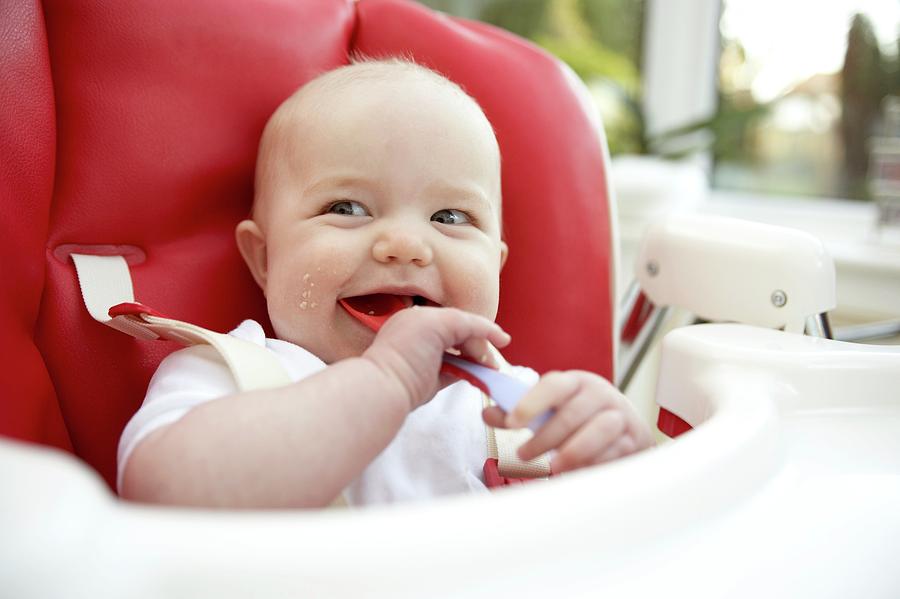 In fact, the teeth we use to chew are the molars, and those teeth generally don’t come in until well after baby’s first birthday.15
In fact, the teeth we use to chew are the molars, and those teeth generally don’t come in until well after baby’s first birthday.15
Babies’ gums are incredibly strong – if your little one has ever gnawed on your finger when teething, you know! And as long as the foods you present to your baby are size and texture appropriate, they can chew perfectly well without a full mouth of teeth.14
Ideally, the food you provide your little one should be soft and pea-sized to prevent choking. Make sure the food is ‘smushable’ between your fingers so that it’s soft enough to be gummed by your baby.
How to start teaching your baby to self-feed with finger foodsA good way to start is placing a few small pieces of food on your baby’s highchair tray. Let your baby feel it. It may seem as if baby is just playing with the food, but touching and playing is a step in their learning process.2,5
Initially, your baby may grab for the food with a raking motion, using the entire fist to move the food toward their mouth.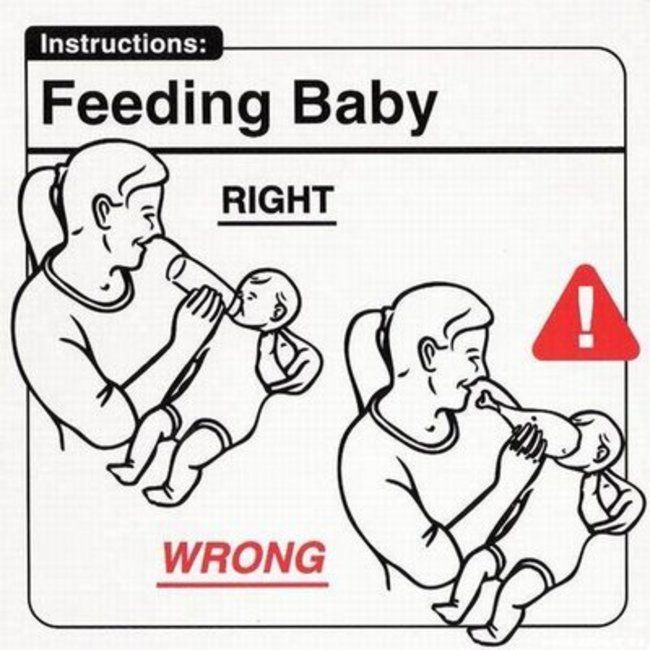 Grabbing the food in this way is called the palmer grasp, which is when baby’s fingers close over an object (such as your finger) in the palm of their hand.16
Grabbing the food in this way is called the palmer grasp, which is when baby’s fingers close over an object (such as your finger) in the palm of their hand.16
Around 9 months, your little one will develop the fine motor skill of grasping food with their thumb and forefinger, called the pincer grasp.5
Read more: Introducing Solids: First Foods and Advancing Textures
When to practice self-feedingYou can go about practicing self-feeding in many ways. First, try setting aside time at the beginning of the meal for practice. Since baby is hungrier at the start, this may help in motivating your little one to bring the food to their mouth themself.
Another way to try is to simply leave several pieces of food on baby’s tray to play and practice with while you alternate with spoon feeding. Allow your little one to try and put food in their mouth, then practice chewing and swallowing. Be sure that baby’s mouth is clear of food before offering anything from the spoon.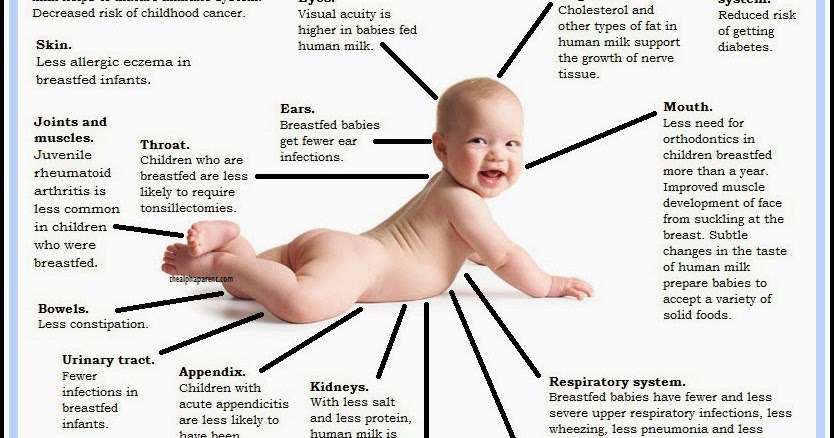
If your baby gets frustrated, allow them to finish the meal and eat how they normally would (such as with spoon feeding). Just remember to keep trying at other meals throughout the day (and every day).
Read more: Meal Plan for 6 to 9 Month Old Baby
First finger foodsThe foods you give your baby to practice self-feeding should be soft, easily ‘smushed’ between your fingers, and cut into small pea-sized pieces.
Here are some ideas for first finger foods:
Small pieces of ripe, soft bananas, avocados, peaches, mango, kiwi
Soft cooked sweet potatoes, carrots, butternut squash, turnips
Grated or soft cooked (skinless) apples and pears
Soft cooked whole grain pasta
Scrambled eggs
Cubes, strings, shredded, or small pea-sized pieces of cheese
Cooked shreds, small diced pieces, or ground cooked chicken, fish, or turkey
Berries cut into quarters
Beans cut into halves or quarters
In addition to the above ideas, your baby can eat bits of what you eat (without added salt or sugar) including different fruits, veggies, grains, meat, beans, spices and seasonings as long as the foods are small and soft enough to reduce choking risk.
Foods that pose a risk of choking should be avoided. Examples include nuts, whole grapes, hot dogs, raw carrots, raisins, popcorn, and portions of food that are too large.14 Also note that honey should not be given to infants before the age of 1 year.
Read more: Preventing Choking in Infants and Toddlers
Time to practice with spoons and cupsLearning how to use spoons and cups not only involves demonstrating how to use each one, but also allowing your baby lots of practice both with your help and without. Let your little one get messy as they step into their independence with eating and drinking!
Teaching your baby to use a spoonAfter your baby masters self-feeding with their hands, the next step is offering utensils. Most children become good at using spoons and forks to self-feed between 15 to 18 months, but that doesn’t mean you need to wait until then to start exposing them to utensils. 1,6,7
1,6,7
Just as your baby needed a lot of practice eating with their hands, they will also need many opportunities to attempt eating with utensils. A good way to begin encouraging this transition is to give them their own baby or toddler-friendly spoon or fork.
Teaching your baby to use a cupLearning to drink from a cup can also begin around this time.4,7 Use an open, sippy, or straw cup and allow your little one to practice with a small amount of water. Since formula and/or breastmilk will still provide a large amount of nutrition and all of the hydration for your little one at this age, only about 4 to 8 ounces of water total spread through the day are recommended.8
Letting your baby drink water from a cup on their own will not only build their fine motor skills (which may include lots of spills!), but will also help them form the important habit of drinking water.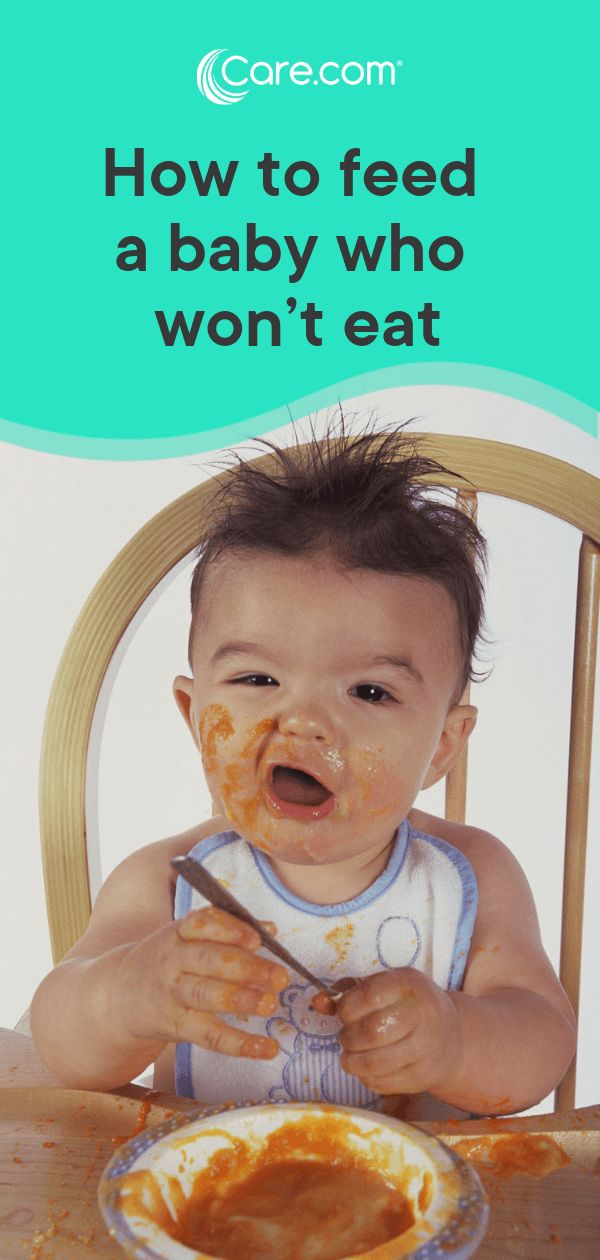 8
8
Which should you use: cups? Sippy cups? Straw cups? Learn more here: Transitioning to Cups for Babies and Toddlers
Which foods to use when practicing using a spoonThicker foods like oatmeal, mashed sweet potatoes, or yogurt blended with fruit are good practice foods since they will more easily stick to the utensil. It will be messy for a while but just remember that practice makes progress.
Once your baby has gotten the hang of dipping the utensil into the food and bringing it to their mouth, consider giving baby their own small bowl. There are some bowls with suction cups on the bottom and some that are attached to a mat – these may help prevent too many spills.
Let your baby to feed themself from their bowl while still feeding them from yours. Soon enough they’ll be eating a full meal without your help!
Remember, it is a learning process; it will take quite a while before your little one is neatly and skillfully feeding themself. In the meantime, have fun and be prepared to get messy!
In the meantime, have fun and be prepared to get messy!
It’s important to monitor your baby as they begin to eat more independently. Your baby is not only getting used to a new way of eating, but new textures too. Remaining by your baby during meals will allow you to monitor their tolerance for new textures and the amounts they are putting into their mouth.9
Know the difference between gagging and chokingGagging is the body’s natural defense against choking and is very common when babies start eating solid foods.10,11 Gagging may occur if the baby has too much food in their mouth or if the food moves towards the back of the mouth before they have chewed it sufficiently. While your baby may look scared and be making gagging noises, baby’s airway is not blocked.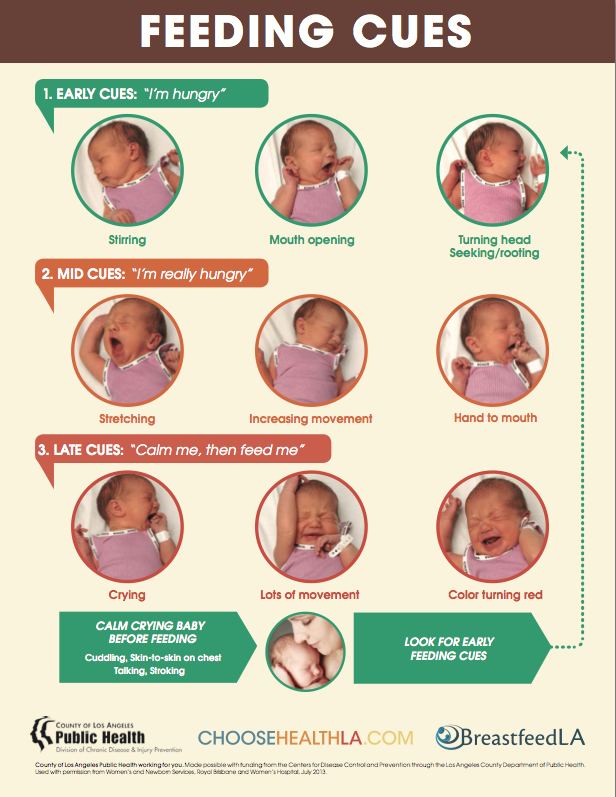 The gag reflex helps baby move the food back toward the front of the mouth so they may chew it more before swallowing.
The gag reflex helps baby move the food back toward the front of the mouth so they may chew it more before swallowing.
Choking is when a piece of food becomes lodged in the airways causing baby to stop breathing.12 Your baby will be silent and perhaps flailing their arms. Choking is life threatening and requires immediate attention.
Learn more: Preventing Choking in Infants and Toddlers
Expect and embrace the messTeaching your baby to feed themself will be messy. Invest in a few good bibs or apron type smocks that can better catch the food. Consider placing an old towel underneath the highchair if you are concerned with food falling on the floor. Keep a damp washcloth or paper towel by your side to help with spills.
Enjoy family mealsBabies learn from you! If your baby is eating meals with the rest of the family, they will observe how everyone else is using their utensils to feed themselves, eating healthy foods, as well as other appropriate mealtime behaviors. 4,13
4,13
Read more: Family Meals: Developing Healthy Eating Patterns
Be patientLearning to self-feed takes time. Allow plenty of time for meals and never rush your baby to finish. Your little one is eating at the pace they are most comfortable with, allowing them to boost their learning.
Let's Chat!We know parenting often means sleepless nights, stressful days, and countless questions and confusion, and we want to support you in your feeding journey and beyond.
Our Happy Baby Experts are a team of lactation consultants and registered dietitians certified in infant and maternal nutrition – and they’re all moms, too, which means they’ve been there and seen that. They’re here to help on our free, live chat platform Monday - Friday 8am-6pm (ET). Chat Now!
Read more about the experts that help write our content!
For more on this topic, check out the following articles:Introducing Solids: Signs of Readiness
Learning to Love Healthy Foods
Understanding your Baby’s Hunger and Fullness Cues: Responsive Feeding
Introducing Solids: Baby Led Weaning
Feeding Tips for Healthy Weight Gain in Infants and Toddlers
Nutrient Needs and Feeding Tips for 6 to 12 Month Olds
Sources
Read online “My child eats by himself.
 Complementary foods with pleasure”, Polina Kazimirova – LitRes
Complementary foods with pleasure”, Polina Kazimirova – LitRes © Kazimirova P., 2020
© Design by Eksmo Publishing House LLC, 2020
* * *
I dedicate this book to my parents who believed and believe me so far in every situation; to my husband, who never doubted for a second the success of my project and became the very wind in my wings that helped me soar; my children, without whom there would be nothing, all my way is for their sake and in their name. nine0011
Foreword by Jill Rapley
When I first introduced the concept of Baby-Led Weaning in 2001, I had no idea how far and how quickly interest in this approach would spread around the world. But gradually, as more and more parents read or heard about self-feeding, it began to gain momentum. Many intuitively knew that BLV made sense, and when they began to pass control over their meals to their children, they saw for themselves how well it works! nine0003
Self-feeding (or SFE) is a natural extension of a child's instinct to explore, to learn how his body works, to interact with the world around him. It is also a natural extension of its ability to feed on its own. He can do it at birth, why shouldn't he be able to do it at six months? Allowing your child to move to the family table at their own pace, learning smells, tastes, textures, shapes and colors along the way, is to lay the foundation for a lifelong positive relationship with food. If we do everything right from the start, we will help our children to be healthy and achieve well-being. nine0003
It is also a natural extension of its ability to feed on its own. He can do it at birth, why shouldn't he be able to do it at six months? Allowing your child to move to the family table at their own pace, learning smells, tastes, textures, shapes and colors along the way, is to lay the foundation for a lifelong positive relationship with food. If we do everything right from the start, we will help our children to be healthy and achieve well-being. nine0003
Self-feeding is not new; it has been practiced by many generations of parents all over the world. But until recently, it didn't have a name, so it was hard to discuss, write about, or research. Since self-feeding was not officially recognized, the parents who practiced it kept their thoughts to themselves, which meant that new parents were not even aware of such an option. That has now changed, and families around the world are discovering the benefits of self-feeding as an opportunity to give their children the right to introduce complementary foods on their own and naturally. nine0003
nine0003
I am delighted that this book will bring the idea of BLV to families and childhood professionals in Russia. Understanding children's natural instincts and abilities helps us gain respect for their autonomy and trust them to know what they need. Whether you're a parent-to-be, an established parent, a grandparent, a child care worker, or a healthcare professional, if you want to help kids on their journey to lifelong healthy eating and the true enjoyment of food, this book is for you! nine0003
Jill Rapley, June 2020
Author's Foreword
In my first experience of motherhood, I found it extremely difficult to find a competent specialist with modern knowledge of complementary foods. It is difficult to resist their authority and "experience", which, unfortunately, has little value and often needs to be revised. Because it becomes unclear where the specialist’s personal opinion and his belief in “everyone does it” ends and where modern knowledge based on evidence-based medicine begins. nine0003
nine0003
I have often heard phrases like “children should be fed exclusively canned puree until the age of two”, “apple juice should be given from birth”, “first give vegetables, and then fruit, otherwise the child will get used to sweets and will not want vegetables”, “ citrus fruits are an allergen, it is impossible for up to a year” or “from cucumbers in children with colic”. You can continue indefinitely. These folk wisdoms pour on young mothers from everywhere. Indeed, it is difficult to resist them, because they are pronounced by people whom we trust.
I could say that this book is the fruit of my anger. Angry at all the misleading clues I received in my first motherhood experience. I was advised to introduce complementary foods at four months, feed purees for up to a year, follow strict patterns, and offer my child the same mess at every meal every day, citing the fact that "he still does not understand anything." nine0003
Are you sure? The youngest daughter, with whom we from the very beginning followed the path of self-feeding, already at seven months confidently put aside those foods that she did not like and chose her favorites.
How angry I was at those who pushed me to doubt my child, who convinced me of the need for completely useless circuits and accessories. Yes, dear readers, anger was the first driving force in the creation of this book.
But as I blogged, studied, communicated with adequate and competent pros in the field of breastfeeding and complementary foods, I realized that, fortunately, not everything is so bad. There are qualified professionals. And they really give adequate recommendations based on research and recommendations from international organizations. nine0003
Then I was overcome by the urge to expose. Yes, exactly to expose all those charlatans who continue to advise apple juice to a three-month-old baby or forbid fish to children until they can pronounce the word "fish". How many of them! And how they discredit all the recommendations for the introduction of complementary foods, all the work of competent specialists.
The more I immersed myself in the topic of complementary foods, the more I realized that all those myths and legends that surround the entire process of introducing babies to solid food, even casually, have nothing to do with real WHO recommendations. nine0003
nine0003
From this, another need arose - to share your knowledge with other mothers so that they can fend off the attacks of moldy pediatricians who have not heard about the WHO recommendations. So that they know that complementary foods are not about jars of purees up to three years old and not about feeding giant portions from a spoon. Complementary foods are about getting to know food, about the beginning of a lifelong journey.
With this book, I want to not only tell you that purees and cereals have a worthy and safe alternative in the form of self-feeding. I want to revolutionize the current system of introducing complementary foods, which is dominated by baby food manufacturers and incompetent doctors, and not by the interests and preferences of the child and competent consultants. It’s hard to believe that, despite the constantly updated knowledge of the physiology of the child, an incredible amount of research in the field of child nutrition, there are still so many prejudices and “folk wisdom”. And this book is a challenge to prejudices. This is my attempt to reach out to everyone involved in breastfeeding. And even if you read this book and still follow the path of classic pediatric complementary foods, my mission will be completed. You will have the knowledge that I did not have seven years ago when I introduced complementary foods to my eldest son and was completely captive to strict rules and prejudices. nine0003
And this book is a challenge to prejudices. This is my attempt to reach out to everyone involved in breastfeeding. And even if you read this book and still follow the path of classic pediatric complementary foods, my mission will be completed. You will have the knowledge that I did not have seven years ago when I introduced complementary foods to my eldest son and was completely captive to strict rules and prejudices. nine0003
This book is not only based on medical research, recommendations from competent organizations and luminaries in the field of pediatric nutrition. Collected here are my personal experiences with pediatric complementary foods with my first son and self-feeding with my daughter, as well as the experiences of thousands of mothers who have successfully practiced the BLV technique.
How parents around the world evaluate the method of self-feeding
“Polina, you have no idea what a great job you are doing! My daughter is 8 months old, since 6.
5 she has been on self-feeding. I found your blog just in time and began to study. At the beginning of feeding, my daughter refused mashed potatoes and did not want to be fed from a spoon. Having tried to eat on her own, her happiness knew no bounds, and so did mine. It is a pleasure to watch a happy smacking child. True, at first the grandparents were in shock, but now everyone is watching the process with tenderness.” nine0011
Ekaterina, Ufa
“Polina, thank you for your knowledge. You have changed our lives. In a good way."
Inga, Minsk
“If it wasn’t for you and your Instagram account, we wouldn’t have food interest. And both of us and my son would cry because I push porridge into him while he is in a reclining position in a car seat. And we did this for two weeks: both he and I with tears. Thank you very much for your work." nine0003
Natalia, Barnaul
“Every day we sit and admire the skills of our eight-month-old baby: how she chooses what she likes best, is not afraid to try new food.
All this is very interesting to watch. And it's very captivating."
Tatiana, Kyiv
“Polina, I am grateful to you for your help and dispelling my fears. Thanks to you, our joint meals bring great pleasure and many positive emotions to our entire family. Our joy knows no bounds." nine0003
Antonina, Volnyansk
“You are just a fairy for moms. Self-feeding really makes mom's workdays easier. There is time to eat in peace. Thanks".
Anna, Tel Aviv
“Since I started feeding my baby, I have been sitting, eating and enjoying myself. And the baby sits, eats and rejoices. And most importantly, he eats himself and what he likes. Thank you, you have dramatically improved my motherhood.”
Irina, Moscow
“How interesting it is to watch a child trying to eat on his own, how he explores this world with such diversity.

Special thanks for changing my ideas about the right diet. Self-feeding performed by Polina is not just an alternative to pediatric complementary foods. This is the improvement of family values and the acquisition of a healthy diet. You have made my life easier by removing a lot of myths about food.” nine0003
Zareta, Shali
“I am happy that I discovered self-feeding for my child. We have been eating slices since six months and we love it. We have already tried many products, and we recently turned only 7 months old. I am glad that our child can sit at the same table with us and eat our food on his own.
You make mothers and their children calmer and happier.”
Christina, St. Petersburg
“Thanks to you, my baby eats with a spoon at 10 months. All relatives are shocked. Grandmothers film and brag to their friends.
”
Natalia, Rivne
“My son Leo is 8 months old. I am happy to see how he smiles every time it's time for a meal, and with what pleasure he tries new dishes and products. You not only profess self-feeding, but also very delicately teach us to trust our children, dispel fears and doubts.” nine0003
Anna, Parma
“Self-feeding is the same unreal bond with the baby as with breastfeeding: he watches you eat and does the same. Constantly watches you while you eat, very carefully. And if I eat, then he continues. I even have time to drink tea.
Xenia, Moscow
Part one. Why I chose self-feeding
Chapter 1. What is self-feeding
It was time for lunch. Svetlana, the mother of five-month-old Gleb, began to prepare for him in the morning, because it was perhaps the most important dinner in her life - today she begins to introduce complementary foods to her first child.
The day before they were at a pediatrician's appointment, who said that it was time for Gleb to be fed, as his mother's milk was starting to run out.
Svetlana was embarrassed by this, because the baby was gaining weight very well, he was always cheerful and complacent. He did not give the impression of a child who lacks something. In addition, he has not yet sat and looked at food - how to feed him? Moreover, Svetlana recently read in some blog about complementary foods on Instagram that the WHO recommends starting the introduction of complementary foods no earlier than six months. But she trusts her pediatrician, but she has never seen a blogger. He certainly cannot know what is best for her child. nine0003
Full of doubts and inner torment, a young mother prepares steamed fresh zucchini bought in a special bioshop. Then he carefully grinds the vegetable with a homogenizer purchased for this important mission.
Done. Svetlana solemnly puts Gleb into a highchair in a semi-recumbent position. She keeps her phone ready so that she can take a picture of a happy baby munching on a zucchini and send it to her husband. The first spoon rushed to little Gleb. Svetlana pronounces a drawn-out “A-a-a-m”, while opening her mouth. Gleb enthusiastically repeats after his mother and ... the goal is achieved! The first spoonful of the first food was in the baby's mouth. Moments of joy and pride for yourself and your child; a feeling of guilt that I did not fully trust the pediatrician and doubted; tears of joy that her baby is starting a new stage in life. Svetlana did not have time to enjoy the wave of emotions, because she heard the squeamish “Be-e-e”, and Gleb spat out the zucchini on the table with displeasure. Complete fiasco. nine0003
She keeps her phone ready so that she can take a picture of a happy baby munching on a zucchini and send it to her husband. The first spoon rushed to little Gleb. Svetlana pronounces a drawn-out “A-a-a-m”, while opening her mouth. Gleb enthusiastically repeats after his mother and ... the goal is achieved! The first spoonful of the first food was in the baby's mouth. Moments of joy and pride for yourself and your child; a feeling of guilt that I did not fully trust the pediatrician and doubted; tears of joy that her baby is starting a new stage in life. Svetlana did not have time to enjoy the wave of emotions, because she heard the squeamish “Be-e-e”, and Gleb spat out the zucchini on the table with displeasure. Complete fiasco. nine0003
Swallowing the lump in her throat, she tried again. Perhaps Gleb simply did not taste it. But the son refused to repeat the experiment. Svetlana tried to distract the child with songs and rhymes, but this did not bring any result. Gleb only burst into tears, and his mother hardly managed to calm him down. As of today, weaning has been completed.
As of today, weaning has been completed.
The frustrated mother put her son to bed and thought. How I wish things were different! So that the baby enthusiastically tastes what she has prepared for him with such love. So that meals for my son are always a pleasure. Yes, Svetlana firmly decided that today was the first and last time her son cried at the table. She will do everything so that the child runs to the table with joy. Just to figure out how. nine0003
* * *
There are a great many stories like the one that happened to Svetlana and Gleb. Someone decides that this is how it should be, that the child should get used to it, so he continues to insist and feed in spite of the tears and protests of the baby. Someone turns on cartoons, and the child, as if hypnotized, obediently opens his mouth. And someone is looking for alternatives, subconsciously feeling that everything could be different. And finds!
Self-feeding has become such an alternative for me.
Self-feeding - a method of introducing solid foods, in which the child from the very beginning of complementary foods eats independently from a common family table. He becomes the main protagonist of complementary foods, independently manages the entire process. nine0003
He becomes the main protagonist of complementary foods, independently manages the entire process. nine0003
The term "self-feeding" is an adapted translation of the original or "bw" name "baby-led weaning". Baby-led weaning was first described by Gill Rapley in her book Baby-Led Weaning, published in 2008 in the UK. Rapley developed this method while conducting research on the readiness of children to feed for her magistrate work. By that time, Jill was already an experienced midwife and lactation consultant. nine0003
In 2015, Jill Rapley received her PhD in Philosophy. The research for PhD Jill was based on a comparison of the types of feeding a child: with a spoon and on its own. The research results have been published in a number of reputable medical journals. I often refer to them throughout the book.
Jill Rapley is also a mother of three children, on whom the method of self-feeding has been successfully tested and studied.
This approach is currently recommended by the UK Department of Health and is widely used in the US, New Zealand and Western Europe. nine0003
nine0003
In Italy, where I live, many paediatricians are openly in favor of self-feeding. The authoritative UPPA magazine writes regularly about this approach as a safe and natural way to introduce children to solid foods.
With self-feeding, there are no food introduction schemes, no spoon feeding, no purees and jars, no special baby food. There is no set “correct” date for when a child should start solid foods.
And it's not the pediatrician or us, the parents, who decides when it's time to start. The baby will do it. Parents cease to be guardians of their own children by their own children. The goal - to feed the baby at any cost - is no more. Everything is different here. nine0003
How does it work? Very simple! When you see that your baby is ready (we will talk about this in detail in the following chapters), just boldly offer him what he is interested in at that particular moment. Put in front of the child on a plate or directly on the table a few pieces of each product that the parents have on the plate, and let the baby experiment. Give him the opportunity to pick up food himself, touch it, smell it, perhaps smear it on the table, and perhaps put it in your mouth and eat it. Do not feed, do not persuade, do not entertain. nine0003
Give him the opportunity to pick up food himself, touch it, smell it, perhaps smear it on the table, and perhaps put it in your mouth and eat it. Do not feed, do not persuade, do not entertain. nine0003
For example, we just sat down at the table and began to eat calmly, showing our daughter with our whole appearance that we expect the same from her. By the way, she did not disappoint us. On the very first joint dinner, she got herself a macaroni and deftly put it in her mouth. We hid and watched, and with rare agility she dealt with it and immediately reached for a new one.
It is important to remember that we, parents, become just a tool for our kids in learning about the world of food. We are their partners in a new journey into the world of tastes, smells and textures. nine0011
After all, if you think about it, we open the door for our children on a journey that will never end. Food will be present in the lives of our children, and then adults, always, every day. Our task is to make this trip pleasant, full of smiles and peaceful shores. All future eating habits and preferences of children are in our hands. It is up to us what our child's relationship with food will be.
Our task is to make this trip pleasant, full of smiles and peaceful shores. All future eating habits and preferences of children are in our hands. It is up to us what our child's relationship with food will be.
Let me note right away that the main goal of self-feeding is not to feed the child immediately, but to smoothly introduce him to a variety of foods, tastes and textures. Let the child decide for himself what and how much to eat from the food offered. At the same time, up to a year of a baby's life, according to WHO recommendations, mother's milk or formula remains the basis of a child's nutrition. Complementary food becomes only its addition. In no case do we try to immediately replace milk with complementary foods. nine0003
Over time, when the child realizes that what he swallows fills him up, he will increase the portions of complementary foods and reduce milk feedings. Myself. At your own pace. With my own hands.
In fact, the child introduces complementary foods on his own! A child plays with food, which at his age is the only way to know the world. And just in the process of casual play, research and experimentation, the baby will first want to bring a piece of food to his nose, smell it, then, perhaps, touch it with his tongue ... And only then, at his own pace, at the moment when he is really ready, he will send it in the mouth and to the delight of the mother even chew and swallow. nine0003
And just in the process of casual play, research and experimentation, the baby will first want to bring a piece of food to his nose, smell it, then, perhaps, touch it with his tongue ... And only then, at his own pace, at the moment when he is really ready, he will send it in the mouth and to the delight of the mother even chew and swallow. nine0003
Tatyana, mother of an 8-month-old baby from Israel, explains her decision to introduce new food into her son's diet using self-feeding:
new recommendations reached us, and complementary foods started strictly at the age of six months). I remember quite well my preschool and school childhood and what was connected with food: basically it was the endless persuasion of my parents so that I could eat, including phrases like “you won’t leave the table until you finish”, “you have to eat soup, otherwise, the stomach will hurt, ”etc. I went to every meal as if I were going to hard labor. This went on for quite a long time - until high school, until I started cooking myself and was able to independently choose the composition of the dishes.
I don't want food to become hard labor for my child. I want my son to enjoy food and understand his needs. nine0011
My sister is raising two aged sons using the self-feeding method. One picture I remember for a long time: two kids, with an appetite eating meat from lamb ribs. The moment I saw these happy children, I decided that I wanted the same.”
Chapter 2. My way from traditions to… origins
When my son, the first and long-awaited one, was born, I was not ready. And this despite the fact that I read a huge amount of literature on motherhood. I, like many mothers, was overly responsible, I was afraid to make a mistake, to harm my baby due to a complete lack of experience in being a mother. So I was looking for someone I could trust. This person for us was a pediatrician who “led” our son: a handsome, smiling middle-aged man made him feel at ease, and even aroused awe and a certain fear. He spoke so confidently, supported breastfeeding, which was a very important indicator for us, and we trusted.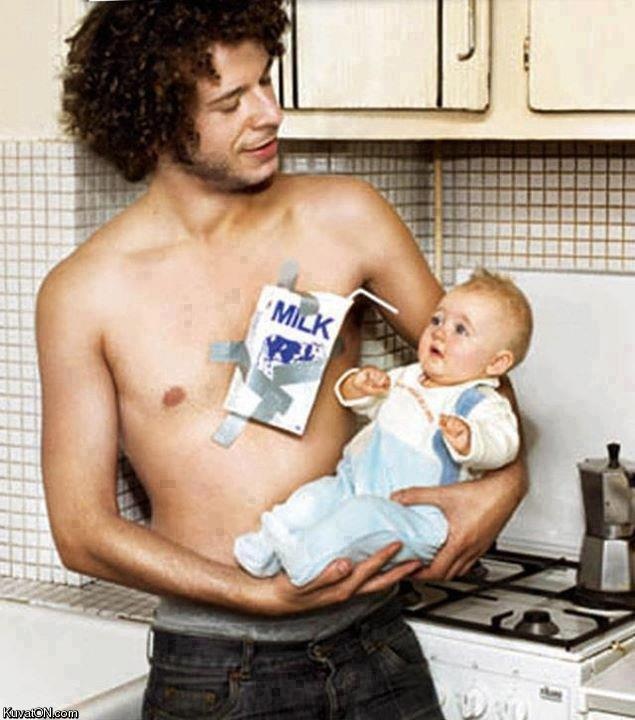 nine0003
nine0003
It turned out that he was a bit stuck in the past. And despite the fact that our son was exclusively breastfed, at four and a half months he recommended that we start giving the baby fruit in order to "teach him to a spoon." Even then, I read the WHO recommendations that complementary foods should be introduced no earlier than six months, but having the deepest confidence in the doctor, for some reason I could not object to him and at five months I began to give my son fruits. At five and a half, we began to offer the child porridge for dinner, and at six for lunch. nine0003
At first, the son enthusiastically devoured the offered food. But a month later, we began to feed the bin more regularly than our own son. He simply refused to eat. We began to entertain him: sing songs, play games while eating, read books. Airplanes, flying hippos, and submarines with a secret base in the son's mouth went into action. For a while it worked: the son ate, but my husband and I did not.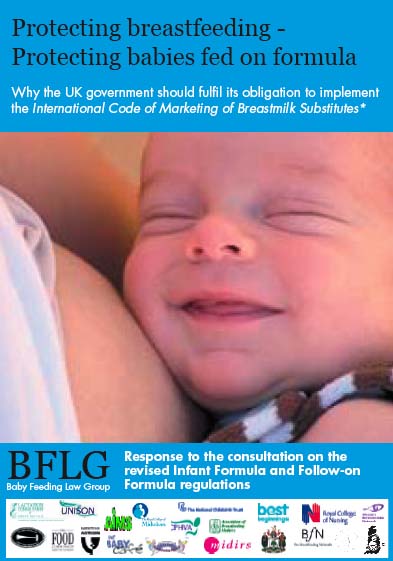 All our strength and time was spent on distracting our son from the plate, and then feeding him with the same food. Our food was regularly left untouched, and we ate dinner after we put our son to bed. This was the moment when we exhaled and for the first time in the evening looked into each other's eyes. Such feedings exhausted us. We both subconsciously understood that this should not be, but we did not see an alternative. We had diagrams and charts on the cork board in the kitchen, issued by the pediatrician, according to which our son ate little, and we felt guilty about this. Therefore, they continued and continued, hoping that the very “beautiful day” would come when the son would start eating on his own and with pleasure. nine0003
All our strength and time was spent on distracting our son from the plate, and then feeding him with the same food. Our food was regularly left untouched, and we ate dinner after we put our son to bed. This was the moment when we exhaled and for the first time in the evening looked into each other's eyes. Such feedings exhausted us. We both subconsciously understood that this should not be, but we did not see an alternative. We had diagrams and charts on the cork board in the kitchen, issued by the pediatrician, according to which our son ate little, and we felt guilty about this. Therefore, they continued and continued, hoping that the very “beautiful day” would come when the son would start eating on his own and with pleasure. nine0003
My son was almost a year old, my husband's father was visiting us, who cooks very well. For lunch, he “conjured” us a risotto with cuttlefish ink. For my son, I prepared a special "children's" porridge. But the son flatly refused. He pointed to my plate with his finger and demanded to taste its contents.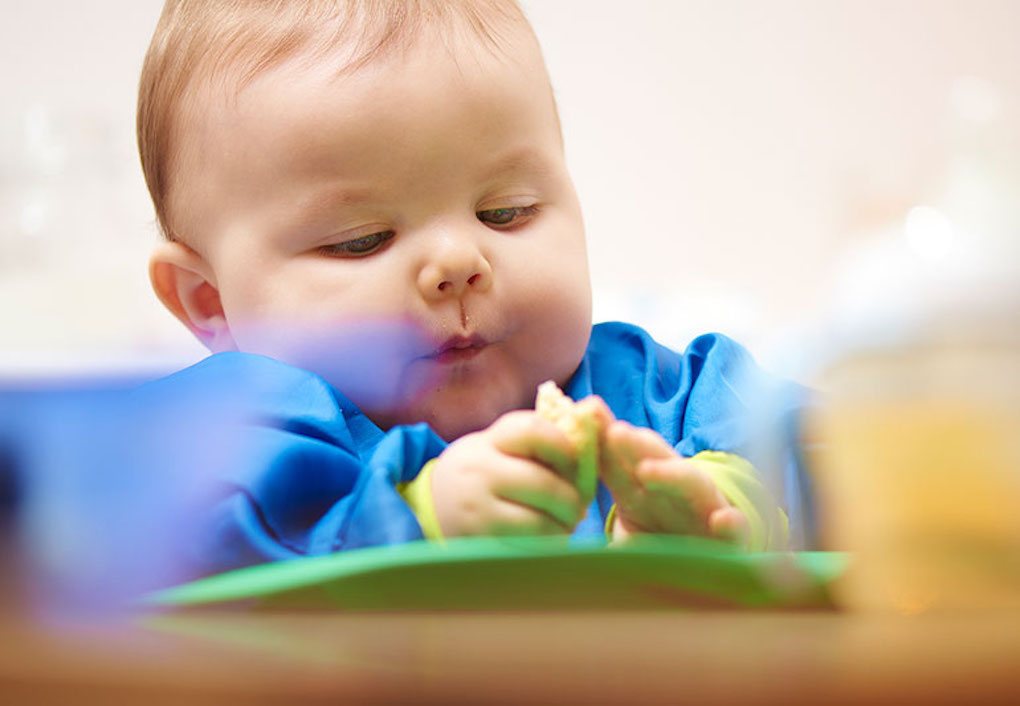 I allowed. My son ate almost all of my portion. This is my son, who categorically refused the variety of baby cereals offered by baby food stores, ate with pleasure. I barely had time to fill the spoon. nine0003
I allowed. My son ate almost all of my portion. This is my son, who categorically refused the variety of baby cereals offered by baby food stores, ate with pleasure. I barely had time to fill the spoon. nine0003
Yes, I forgot to clarify: he demanded to be spoon-fed. But that didn't seem important to me at the time. Son ate! Happy, I called the pediatrician, he said that in a year you can already eat from the common table (I wonder what suddenly changed in my son’s body, what suddenly became possible in a year?). Having received the approval of the doctor, I began to cook all sorts of goodies. For some time we relaxed, although we had to feed Gosha from a spoon, but at least the dances ceased to be an obligatory program. nine0003
By the age of two, the son again went into denial: he began to exclude one product after another from the diet and eventually narrowed the set to a critical minimum. It constantly began to seem to us that our son did not eat enough, that he lacked vitamins and minerals, that we were bad parents, since we could not properly feed our own child.
It couldn't go on like that. I sounded the alarm. She began to actively study the problems of baby food, the reasons for refusing food and narrowing the list of consumed products. So I got acquainted with the works of the Spanish pediatrician Carlos Gonzalez. His book My Baby Doesn't Want to Eat forever changed my approach to nutrition for both children and adults. My world has changed. To this day, in every personal consultation I do, in every self-feeding course launch, and in every webinar, I passionately recommend this book to all parents. This work is the basis of happy family meals. In the process of my searches, I got acquainted with self-feeding. This approach seemed so honest and natural to me that long before the appearance of my daughter, I already knew exactly which way we would go with complementary foods. I was seriously determined not to make the mistakes that we made out of inexperience with our eldest son. nine0003
I studied all the literature available to me on this topic in Italian and English, joined English-speaking support groups on Facebook. Later, when I decided to write this book, I contacted Jill Rapley and actively corresponded with her. She generously shared with me her research and the work of colleagues, answered numerous questions and gave advice.
Later, when I decided to write this book, I contacted Jill Rapley and actively corresponded with her. She generously shared with me her research and the work of colleagues, answered numerous questions and gave advice.
Then a daughter was born. With her, we chose the path of self-feeding. It was always a meal with a smile and pleasure for all family members. I realized that I dream that it would be like this in every family, so that young mothers would not step on the same rake that we went through. I realized that I simply have to share my experience and knowledge with the world. So I became a nutritional consultant. nine0003
My child eats by himself. Lure with pleasure to read online Polina Kazimirova (Page 5)
Chapter 5. Self-feeding is natural
Have you ever thought that a baby is born at the exact moment when it should be? The child finds the mother's breast because it follows its natural instinct. The child begins to suck it to feel the closeness of the mother, to calm down, to satisfy hunger. We did not teach this to the baby: neither how to suck, nor how much to suck, nor when to stop doing it. He knows this himself, and we trust him. The baby cries when he needs something, when he feels bad, when he is hungry or looking for his mother. Nobody taught him this, it was given to him by nature, he instinctively knows how to call for help. Mom always hears her child, understands him and rushes to the call. nine0003
We did not teach this to the baby: neither how to suck, nor how much to suck, nor when to stop doing it. He knows this himself, and we trust him. The baby cries when he needs something, when he feels bad, when he is hungry or looking for his mother. Nobody taught him this, it was given to him by nature, he instinctively knows how to call for help. Mom always hears her child, understands him and rushes to the call. nine0003
The baby smiled at his mother for the first time, because he recognized her, he heard her native and affectionate voice, saw a loving smile, felt a gentle kiss. No one taught him this, he just knows how to smile when he feels good and calm, when his mother is near, when he is warm and satisfying.
We take it for granted, it's natural for us. Nature took care of this, as it took care of the fact that the baby learned to sit, crawl, walk, talk. After all, we don’t get on all fours and teach our baby to crawl, right? We do not roll over from stomach to back and from back to stomach in front of the child, so that he quickly mastered this skill. nine0003
nine0003
...
Then why aren't we ready to trust him to transition to solid foods? Why do we think that nature has not taken care of such an important aspect of a baby's life? Why do we strive to quickly “feed” our crumbs? Why don't we let our children decide for themselves when, what and how much to eat?
Up to six months, while we feed our baby exclusively with our own milk, we have no doubts about his ability to self-control. We don’t run after him around the house with a chest, convincing him to “take another sip”. Why do we suddenly not believe our children when it comes to complementary foods? nine0003
Complementary foods are as natural as all other stages of a child's development. We just need to learn to trust our children. They will amaze us with their competence.
Chapter 6. A barrel of honey
In this chapter we will talk about the advantages of self-feeding over the classic pediatric method.
Surely you are wondering: why do I need self-feeding? What is special about it? What kind of experiments on your own child, when there is already a proven method for generations? I'll answer. nine0003
This is a child-respectful approach. There are no persuasion and entertainment feedings, no strict schemes and “correct” products. The child eats from a common table with his family, which means he feels part of this family. He has the right not to like cauliflower or zucchini. Has the right not to want to eat. From the very beginning, we take into account his interests, desires and taste preferences.
This teaches the child to choose. Letting the baby decide what and how much to eat, we teach him to choose. Today - between broccoli and Brussels sprouts, tomorrow - between sweet soda and water. And the day after tomorrow? nine0003
My daughter, for example, already at seven months confidently put aside pieces of food she didn't like and actively resented if we tried to put them back on her plate.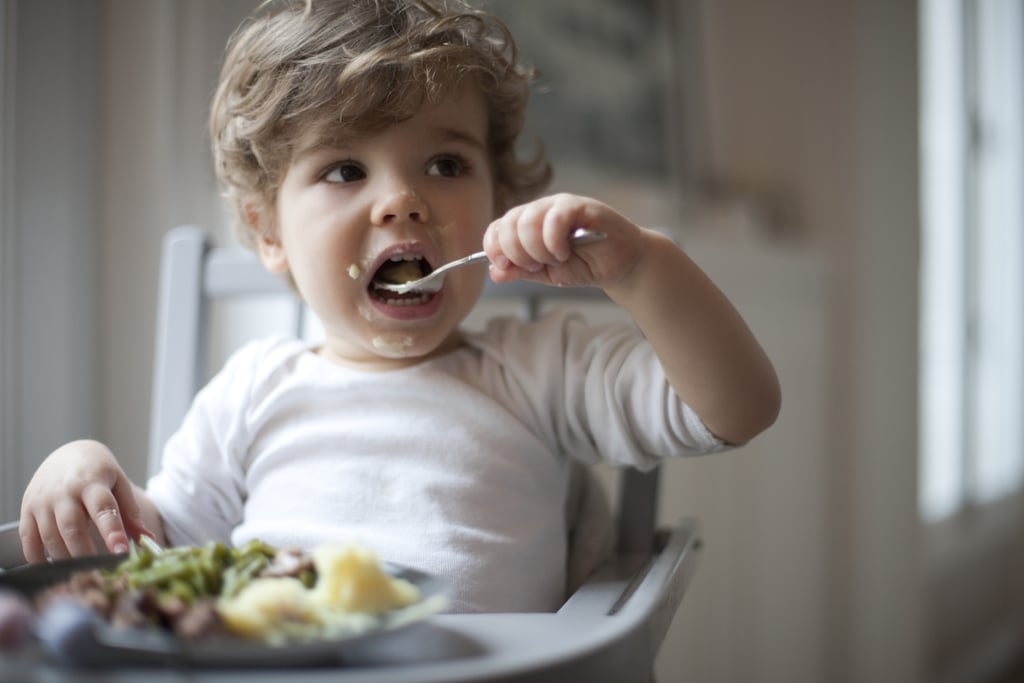
The child learns to feed independently and uses cutlery with ease at an early age. Children acquire skills by imitating adults. And if, from the very beginning of complementary feeding, the baby is allowed to fully participate in the family meal, observe the elders and imitate their actions, then the child will understand how everything works with surprising speed. At the age of seven or eight months, he will quickly bring a full spoon to his mouth, while awakening the boundless pride of his parents. nine0003
By the age of ten months, my daughter was confidently scooping up and putting all kinds of porridge into her mouth, and by the age of one she could also cope with soup.
The baby begins to chew and swallow solid food from an early age. Chewing develops and strengthens the muscles of the face, which will later help the baby when speaking. In addition, even WHO recommends not postponing the introduction of food in pieces and teaching a child to chew up to a year of life.
Your son/daughter gets to know the real look of the food from the very first days of weaning. nine0320 The child knows for sure that not all greens have the same consistency. He knows exactly what to eat broccoli, green peas, spinach, zucchini. And all these vegetables have their own taste, smell and texture, this is not a monotonous green slurry, from which it is not known what to expect. The kid learns to distinguish carrots from pumpkins, cauliflower from zucchini. Everything has its name, shape and texture. You can discuss with him that broccoli is a little prickly and bitter, carrots are sweet and fibrous, and tomato is explosive and juicy. nine0003
As children eat with their hands at first, they learn to pick up objects of different sizes and textures with their fingers. Thus, babies develop fine motor skills. This will further help in learning to write and draw. The baby will begin to confidently pick up a pencil earlier. In addition, the development of fine motor skills is directly related to the development of speech.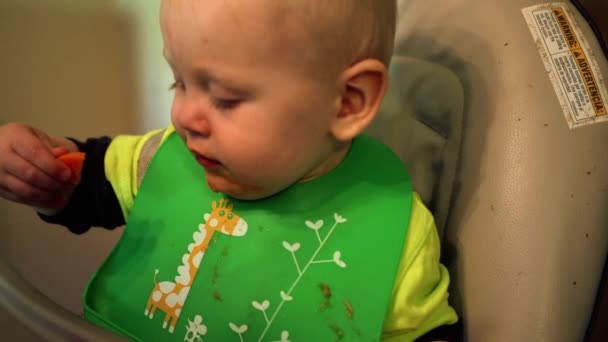 It turns out an educational game in the process of eating. Everyone is interested, and also useful, and at the same time, mom eats calmly and admires her little happiness. nine0003
It turns out an educational game in the process of eating. Everyone is interested, and also useful, and at the same time, mom eats calmly and admires her little happiness. nine0003
It is curious that our eldest son, whom, as you already know, we introduced complementary foods by the classical method, learned to peel tangerines by the age of three. To be honest, we never even thought of letting him do it on his own. He seemed to be too small for that. And the youngest self-feeding daughter, already a year old, seeing me peeling a tangerine, snatched it from my hands and easily continued the splashing business. Since then, only Katerina cleans citrus fruits in our family. You should have seen how nimble she is! nine0003
Of course, this does not mean that she learned to peel tangerines by self-feeding. This means that we have simply learned to trust our child, even in those aspects that are considered to be “not childish”.
By allowing children to feed themselves, we increase their self-confidence. We let the baby know that we trust him. When we give a child the opportunity to feed on his own, we seem to say to him: “Come on, baby, I believe in you! You can, you can do it!" I often noticed how pleased my baby was when she managed to bring a full spoon to her mouth. Eyes sparkled with delight! nine0003
We let the baby know that we trust him. When we give a child the opportunity to feed on his own, we seem to say to him: “Come on, baby, I believe in you! You can, you can do it!" I often noticed how pleased my baby was when she managed to bring a full spoon to her mouth. Eyes sparkled with delight! nine0003
When self-feeding, the baby independently controls the amount of food eaten, which helps to avoid overeating. With this approach, you will soon notice that he eats less than if you spoon-fed him. This is quite natural. When we feed a baby, the pace of food intake is quite high. Often the child, having had enough, still continues to open his mouth and let in another “ship” or “airplane”. This happens a little by inertia, but also because the brain did not have time to receive a signal of saturation. When the child eats on his own, the rate of absorption of food is significantly reduced, and the baby receives the coveted signal from the brain in time that he is full. nine0003
nine0003
Eating with your hands and experimenting with food, its texture, temperature helps children to explore the world. We buy special kinetic sand, tactile books and other gadgets for children so that they can develop. But you can learn the real world in real life situations! How else does a child know that food is warm at first, but if you wait a few minutes, it will cool? Or how will he understand that water flows off a spoon in an instant, and thick sour cream stays on it longer? Who will teach him that if you try to swallow a whole broccoli inflorescence, then nothing sensible will come of it, and if you crush it a little in your mouth with your gums and tongue, you can easily send it to the stomach? Right! Just practice and experience. nine0003
When a baby eats from a common family table, the whole family switches to healthier food. The realization that now our child is sitting at the table with us - the most valuable thing in our life - makes us take a more responsible approach to the choice of dishes. For example, we drastically reduced the level of salt consumed, increased the amount of vegetables and fruits in the diet, completely abandoned frying in favor of baking in the oven. Many moms note that even dads who love sausages are switching to cauliflower and broccoli to set an example for their beloved children. Some say that with the advent of the baby at the family table, the parents lost weight because they began to eat better. nine0003
For example, we drastically reduced the level of salt consumed, increased the amount of vegetables and fruits in the diet, completely abandoned frying in favor of baking in the oven. Many moms note that even dads who love sausages are switching to cauliflower and broccoli to set an example for their beloved children. Some say that with the advent of the baby at the family table, the parents lost weight because they began to eat better. nine0003
I won't lie, we sometimes like French fries too. In the following chapters, we will talk in detail about how to turn unhealthy foods into healthy ones and how to make healthy foods more appetizing.
No more need to persuade to eat and fight for every spoonful. As a result, no stress during family meals. For sure, we, mothers, dream about this long before the start of complementary foods. We draw ourselves sweet pictures of our babies joyfully opening their mouths. And then complementary foods come to our house, and we don’t understand what went wrong and what is our fault when our beloved baby persistently turns away from food.